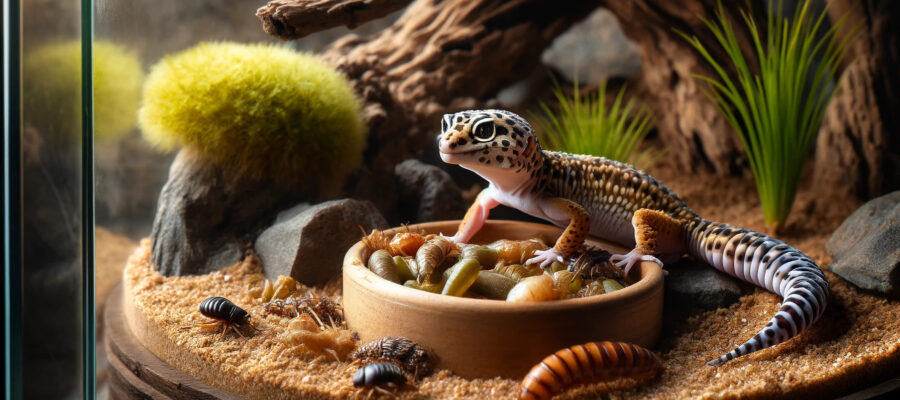Baby leopard geckos are growing machines. They need plenty of nutritious food to develop strong bones, build muscle, and stay active. But how often should baby leopard geckos be fed to keep them healthy and thriving? Let’s explore the perfect feeding schedule and best practices for raising a happy, well-fed gecko.
Why Feeding Frequency Matters
Baby leopard geckos grow fast, especially during the first few months of life. Their bodies demand frequent meals packed with protein, vitamins, and minerals. Feeding them too little can stunt their growth, while overfeeding can cause digestive issues.
A proper feeding schedule ensures they receive balanced nutrition at the right time, setting them up for a long, healthy life.
How Often to Feed Baby Leopard Geckos
Baby leopard geckos (hatchlings to 4 months old) should be fed once or twice daily. Their metabolism is fast, so regular meals keep their energy levels up and promote steady growth.
Here’s a suggested feeding schedule:
- Morning: Offer a small number of gut-loaded insects like crickets or mealworms.
- Evening: Provide another meal when they are most active (leopard geckos are crepuscular, meaning they’re active at dawn and dusk).
What to Feed Baby Leopard Geckos
Baby leopard geckos are insectivores, meaning they eat only live insects. Gut-loaded insects are essential because they transfer important nutrients to your gecko.
Best Insects for Baby Leopard Geckos:
- Crickets: High in protein and easy to digest.
- Mealworms: A staple feeder but should be used in moderation.
- Dubia Roaches: Nutrient-rich and less likely to escape.
- Small Waxworms (as treats): High in fat, so use sparingly.
Tip: Avoid feeding wild-caught insects, as they may carry parasites or pesticides.
How Many Insects to Offer Per Feeding
A good rule of thumb is to feed your baby gecko 5-10 appropriately sized insects per feeding. The insects should be no larger than the space between your gecko’s eyes to prevent choking or impaction.
Dusting and Supplementing Food
To ensure proper nutrition, dust feeder insects with calcium powder and vitamins:
- Calcium without D3: Use daily for hatchlings.
- Calcium with D3: Use 2-3 times a week if there’s no UVB light.
- Multivitamins: Dust once a week for a balanced diet.
Need more details on supplementing? Check out our post on Which Vitamins and Supplements Do Leopard Geckos Need?.
Signs You’re Feeding the Right Amount
Wondering if your feeding routine is working? Here are signs your gecko is getting the right amount of food:
- Healthy Weight: Their body should look plump but not bloated.
- Active and Alert: Well-fed geckos are curious and responsive.
- Regular Shedding: Healthy geckos shed every 4-6 weeks.
- Full, Fat Tail: They store fat in their tails—think of it as their energy reserve.
If your gecko’s tail looks thin or they seem lethargic, they may need more frequent feedings or a more nutrient-rich diet.
Common Feeding Mistakes to Avoid
Even with the best intentions, it’s easy to make feeding mistakes. Avoid these common pitfalls:
- Feeding Insects That Are Too Big: This can cause choking or impaction.
- Skipping Dusting: Skipping supplements can lead to Metabolic Bone Disease (MBD).
- Feeding Dead Insects: Only offer live, moving insects to stimulate hunting instincts.
- Inconsistent Feeding Schedule: Baby geckos thrive on routine, so stick to a consistent schedule.
Transitioning to an Adult Feeding Schedule
By 4-6 months old, you can start reducing feedings to once a day. As they reach adulthood (around 12 months), feed them every other day while keeping an eye on their weight and appetite.
Learn more about feeding routines in our post on How Often to Feed a Leopard Gecko.
Final Thoughts
Feeding baby leopard geckos the right way helps them grow into healthy adults. Stick to a consistent schedule, use gut-loaded insects, and dust them with essential supplements for balanced nutrition.
Explore more tips in our Leopard Gecko Feeding Guides and ensure your gecko gets the care it needs, one meal at a time.
Get Your Free Leopard Gecko Care Checklist!
Are you ready to give your leopard gecko the best care possible? Download our FREE PDF e-book featuring a comprehensive care checklist!
This handy guide covers everything from habitat setup to feeding and health tips, ensuring your gecko thrives.
👉 Download your checklist now!




